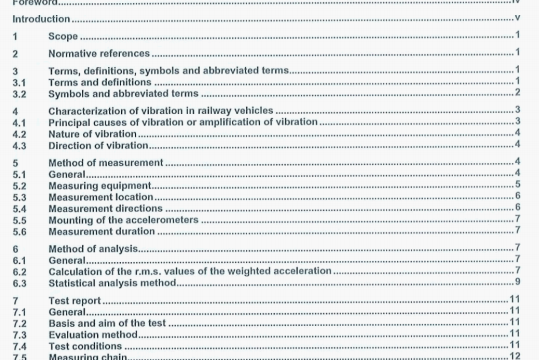ISO 10056 pdf download – Mechanical vibration – Measurement andanalysis of whole-body vibration to which passengers and crew are exposed in railway vehicles.
minimum frequency range: 0 to 128 Hz.
If PCM recorders or dig4al recording are used, anti-allesing filters shall be used. (Usualy these fdters are bui into
the recorders.)
5.3 Measurement location
The acceleration shall be measured on the floor and, depending on the aim of the test, at the man-seat interface (and optionally at the man-beck interlace). The acceleration at a given point in a railway vehicle le dependent on the position of this point In the vehicle. Therefore the measurements should be carried out at the Iolios4ng locations;
on the floor over the boglo centre(s) and, optionaly, at the centre of the vehicle body, arid, doponding on the awn of the lost. on the vestibule floor:
for sealing position if investigated: on and under seats at the centre and, optionally, at both ends of the vehicle
body.
In the driver’s cabin, the measurement should be carried out near the place where the seat Is mounted.
The accelerometers should be mounted on the floor as close as possible (less than 100mm if posalbie) to the vertical poection of the centre of the seat pan, and on the vestibule floor when studng the standing position for local transport.
Other measurement locations may be used depending on the particular aim of the test.
5.4 Measurement directions
The coordinates of the human body are those defined in Figure 1 in accordance with ISO 2631-I. However, a human body-centred coordinate system Is not always well suited for characterizing the comfort or motion relationship in railway environments. ISO 2631-4 therefore defines the following alternative coordinate system when measuring at the car structure (floor);
:.axls: vertical, upwards perpendicular to the floor;
– .x-axia: longitudinal, along the direction of travel;
y-axis: lateral at right angle to the direction of travel.
5.5 Mounting of the accoleromoters
5.5.1 Measurement on the floor
When mounting accelerornelers to the floor, the following points should be borna in mind.
a) The accelerometer shall as far as possible carry the same movement as the part ol the structure to which the seat is mounted.
b) The signals coining from the accelerometer shall not be affected either by any resonance of the accelerometer mounting or by bcal modes of the surface to which it is mounted. Therefore It Is necessary to ensure that the mounting system of the accelerometer and the place where it is mounted are as rid as possible.
More detailed recommendations are given In ISO 5348,
5.5.2 Measurement at man-seat and man.back interfaces
The requirements to be followed when mounting accelerometers at the man-seat or man-back interface are as
specified In ISO 10326-2.
5.6 Measurement duration
The duration of the measLrement shall be at least 20 mm, divided into representative sequences of 5 mm each.
6 Method of analysis
6.1 General
Vibration in raI’way vehicles shall be evaluated In accordance with ISO 2631-1 and ISO 2631-4. The signals measured during the tests should be processed to obtain r,rns, values 01 the weighted acceleration signal. Moreover, to take into account the fluctuating nature of the railway vibration encountered (see 4.2), a statistical method is used for the analysis of all the r,m.s. values of the weighted signal calculated every 5s. This enables the lowest frequencies to be taken into consideration and sufficient vanabilily of the r.m.s. values to be obtained.
The upper frequency limit of analysis may be restricted to a frequency below 60 Hz If provious test results have shovai this to be justiable.
6.2 Calculation of the r.m.s. values of the weIghted acceleration
To calculate the r.m.s. values of the weighted acceleration, the signal should be processed using one of the folIoing methods:
a) analog method;
b) analogIdlgital (hybrid) method:
c) digital method.
The prlndples of these methods are presented In Figures 2 to 4.
ISO 10056 pdf download – Mechanical vibration – Measurement andanalysis of whole-body vibration to which passengers and crew are exposed in railway vehicles
